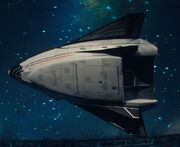
Gala Europa
Le gala Europa était un gala tenu en avril 2024 dans un hôtel à Downtown Los Angeles en l'honneur de la mission spatiale Europa à venir.
Une sécurité renforcée était mise en place durant l'évènement avec de multiples gardes de sécurité, des contrôles de sécurité et des caméras surveillant l'activité des invités et du personnel dans la salle.
Une exposition présentait l'histoire de l'exploration spatiale humaine au 20ème et 21ème siècles.
Afin de surveiller Renée Picard, le groupe de Jean-Luc Picard s'infiltra à cet évènement. Jean-Luc Picard parvint à convaincre l'astronaute Renée Picard de rester sur la mission Europa après avoir discuté plusieurs minutes avec elle. Lorsqu'il la raccompagna, Jean-Luc Picard fut renversé par la voiture du Dr. Adam Soong qui cherchait à assassiner Rene Picard. Le lendemain, Jean-Luc Picard fut interrogé par l'agent du FBI Martin Wells sur les agissements de son groupe durant l'évènement. (PIC: "Two of One", "Mercy")
Invités et personnel[]
- Raffaela Musiker (non-invitée)
- Cristóbal Rios (non-invité)
- Seven of Nine (non-invitée)
- Adam Soong (invité en tant que gros donateur)
CET ARTICLE EST INCOMPLET
Des précisions sur les informations nécessaires à compléter peuvent figurer sur la page de discussion de l'article.
Vous pouvez traduire le contenu figurant dans les autres versions linguistiques de Memory Alpha
ou créer un texte original.
Exposition[]
| Project Mercury was the first manned space program of the United States, running from 1958 through 1963. Its goal was to put a man into Earth orbit and return him safely. Operated by a newly created civilian space agency, NASA, it conducted 20 uncrewed flights and six successful flights by astronauts. The program, which took its name from the god of communication in Roman mythology, cost $2.25 billion (adjusted for inflation). The astronauts were collectively known as the "Mercury Seven", and each spacecraft was given a name ending with a "7" by its pilot. Less than a month after the Soviet Union's Yuri Gagarin became the first person in space, the United States countered with a manned mission on its own. On May 5, 1961, NASA astronaut Alan Shepard launched aboard the Freedom 7 vehicle, becoming the second human being in space. [... A écrire ...] |
- Manned Space Flight 1961-2024
| Less than a month after the Soviet Union's Yuri Gagarin became the first person in space, the United States countered with a manned mission on its own. On May 5, 1961, NASA astronaut Alan Shepard launched aboard the Freedom 7 vehicle, becoming the second human being in space. In December 1968, humanity traveled farther from its home planet than it ever had before, making a trip around the moon and back. As Apollo 8 left Earth orbit, astronauts pointed a television camera back at our planet. For the first time, humanity had a good look of Earth from [...], seeing it as a precious blue marble suspended in the black emptiness of space. In July 1969, Apollo 11 accomplished President John F. Kennedy's goal of landing a man on the moon, Neil Armstrong and Buzz Aldrin walked on the moon on July 21, and returned safely to earth with pilot Michael Collins. Through 1972, a total of six Apollo missions landed 12 men to walk on the Moon and six drive electric-powered rovers on the surface. [... A écrire ...] |
| Launched in 2002, the Nomad MK-15C space probe was the first interstellar vessel designed to seek out new forms of life. Planned as the first probe in a series, its mission was to travel into the void beyound Pluto to look for signs of alien life outside the solar system. The probe's designer, Dr. Jackson Roykirk had one goal in mind: to create a space probe capable of independent logic. In order to process the enormous amount of data gathered by the probe's sensors, Dr. Roykirk designed a revolutionary sperographic array capable of analysing and encoding digital input. Unfortunately, a flaw in the probe's vernier-pulse thrusters was discovered after the launch of the prototype, which meant that Nomad was vulnerable to collision with interstellar debris. After contact was lost with the Nomad probe in 2005, the entire program was cancelled. Dr. Roykirk died in 2020, never knowing if his probe had succeeding in finding interstellar life. |

Maquette de la navette spatiale OV-165
| The OV-165 is a second generation space shuttle orbiter, intended to be a successor to the space shuttle used by NASA from the 1980s through the early 2000s. It was designed to launch commercial and scientific satellites into orbit, as well as components for interplanetary spacecraft such as the Shango. Unlike early space shuttles, which required booster rockets for lift-off and to take them beyond Earth's atmosphere, the OV-165 employs Aerospike engines, which are more powerful and require less fuel. OV-165 is a single stage-to-orbit (SSTO) vehicle - it takes off vertically, lands horizontally, and can be used over and over again, making its operational costs much lower than those of the original space shuttle orbiters. |
- Mission profile / The Solar System
- Could there be life on Europa?
- Shango X-1
Coulisses[]
- Les scènes du gala ont été filmées au Millennium Biltmore Hotel (Rendezvous Court et Main Galleria). [1] [2] [3] [4]












